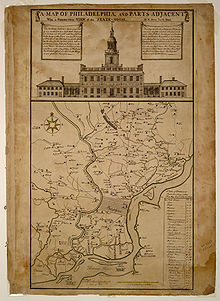Portal:Pennsylvania
The Pennsylvania Portal Pennsylvania (/ˌpɛnsɪlˈveɪniə/ ⓘ, lit. 'Penn's forest country'), officially the Commonwealth of Pennsylvania (Pennsylvania Dutch: Pennsylvanie), is a state spanning the Mid-Atlantic, Northeastern, Appalachian, and Great Lakes regions of the United States. Pennsylvania borders Delaware to its southeast, Maryland to its south, West Virginia to its southwest, Ohio and the Ohio River to its west, Lake Erie and New York to its north, the Delaware River and New Jersey to its east, and the Canadian province of Ontario to its northwest. Pennsylvania was founded in 1681 through a royal land grant to William Penn, the son of the state's namesake. Prior to that, between 1638 and 1655, a southeast portion of the state was part of New Sweden, a Swedish Empire colony. Established as a haven for religious and political tolerance, the colonial-era Province of Pennsylvania was known for its relatively peaceful relations with native tribes, innovative government system, and religious pluralism. Pennsylvania played a vital and historic role in the American Revolution and the ultimately successful quest for independence from the British Empire, hosting the First and Second Continental Congress leading to the adoption of the Declaration of Independence. On December 12, 1787, Pennsylvania became the second state to ratify the U.S. Constitution. The bloodiest battle of the American Civil War, at Gettysburg over three days in July 1863, proved the war's turning point, leading to the Union's preservation. Throughout the late 19th and 20th centuries, the state's manufacturing-based economy contributed to the development of much of the nation's early infrastructure, including key bridges, skyscrapers, and military hardware used in U.S.-led victories in World War I, World War II, and the Cold War. Pennsylvania's geography is highly diverse. The Appalachian Mountains run through the center of the state; the Allegheny and Pocono mountains span much of Northeastern Pennsylvania; close to 60% of the state is forested. While it has only 140 miles (225 km) of waterfront along Lake Erie and the Delaware River, Pennsylvania has the most navigable rivers of any state in the nation, including the Allegheny, Delaware, Genesee, Ohio, Schuylkill, Susquehanna, and others. (Full article...) This is a Featured article, which represents some of the best content on English Wikipedia..
PNC Park is a baseball stadium on the North Shore of Pittsburgh, Pennsylvania. It is the fifth home ballpark of Major League Baseball's Pittsburgh Pirates. Opened during the 2001 MLB season, PNC Park sits along the Allegheny River with a view of the Downtown Pittsburgh skyline. Constructed of steel and limestone, it has a natural grass playing surface and can seat 38,747 people for baseball. It was built just to the east of its predecessor, Three Rivers Stadium, which was demolished in 2001. Plans to build a new stadium for the Pirates originated in 1991 but did not come to fruition for five years. Funded in conjunction with Acrisure Stadium and the David L. Lawrence Convention Center, the park was built for $216 million in 24 months, faster than most modern stadiums. Built in the "retro-classic" style modeled after past venues like Pittsburgh's Forbes Field, PNC Park also introduced unique features, such as the use of limestone in the building's facade. The park has a riverside concourse, steel truss work, an extensive out-of-town scoreboard, and local eateries. Several tributes to former Pirate Roberto Clemente are incorporated into the ballpark, and the nearby Sixth Street Bridge was renamed in his honor. In addition to the Pirates' regular-season and postseason home games, PNC Park has hosted other events, including the 2006 Major League Baseball All-Star Game and numerous concerts. (Full article...)Selected geography article -Larrys Creek is a 22.9-mile-long (36.9 km) tributary of the West Branch Susquehanna River in Lycoming County in the U.S. state of Pennsylvania. A part of the Chesapeake Bay drainage basin, its watershed drains 89.1 square miles (231 km2) in six townships and a borough. The creek flows south from the dissected Allegheny Plateau to the Ridge-and-valley Appalachians through sandstone, limestone, and shale from the Devonian, Mississippian, and Pennsylvanian periods. The valley's first recorded inhabitants were the Susquehannocks, followed by the Lenape and other tribes. The Great Shamokin Path crossed the creek near its mouth, where Larry Burt, the first Euro-American settler and the man who gave the creek its present name, also lived by 1769. In the 19th century, the creek and its watershed were a center for logging and related industries, including 53 sawmills, grist mills, leather tanneries, coal and iron mines. A 1903 newspaper article claimed "No other stream in the country had so many mills in so small a territory". For transportation, a plank road ran along much of the creek for decades, and two "paper railroads" were planned, but never built. (Full article...)Selected image - Credit: surplusparts The Benjamin Franklin Parkway is a scenic avenue that runs through the cultural heart of Philadelphia. Did you know -
Related portalsWikiprojectsThis is a Good article, an article that meets a core set of high editorial standards.
 The city of Philadelphia was founded in 1682 by William Penn in the English Crown Province of Pennsylvania between the Delaware and Schuylkill rivers. Before then, the area was inhabited by the Lenape people. Philadelphia quickly grew into an important colonial city and during the American Revolution was the site of the First and Second Continental Congresses. After the Revolution the city was chosen to be the temporary capital of the United States. At the beginning of the 19th century, the federal and state governments left Philadelphia, but the city remained the cultural and financial center of the country. Philadelphia became one of the first U.S. industrial centers and the city contained a variety of industries, the largest being textiles. After the American Civil War Philadelphia's government was controlled by a Republican political machine and by the beginning of the 20th century Philadelphia was described as "corrupt and contented." Various reform efforts slowly changed city government with the most significant in 1950 where a new city charter strengthened the position of mayor and weakened the Philadelphia City Council. At the same time Philadelphia moved its supports from the Republican Party to the Democratic Party, which has since created a strong Democratic organization. (Full article...)Selected article -During the American Civil War, the Commonwealth of Pennsylvania played a critical role in the Union, providing a substantial supply of military personnel, equipment, and leadership to the Federal government. The state raised over 360,000 soldiers for the Federal armies. It served as a significant source of artillery guns, small arms, ammunition, armor for the new revolutionary style of ironclad types of gunboats for the rapidly expanding United States Navy, and food supplies. The Phoenixville Iron Company by itself produced well over 1,000 cannons, and the Frankford Arsenal was a major supply depot. Pennsylvania was the site of the bloodiest battle of the war, the Battle of Gettysburg, which became widely known as one of the turning points of the Civil War. Numerous more minor engagements and skirmishes were also fought in Pennsylvania during the 1863 Gettysburg Campaign, as well as the following year during a Confederate cavalry raid that culminated in the burning of much of Chambersburg, Pennsylvania. (Full article...)Pennsylvania news
CategoriesState factsState Facts
State symbols
Pennsylvania topicsGeneral imagesThe following are images from various Pennsylvania-related articles on Wikipedia.
Associated WikimediaThe following Wikimedia Foundation sister projects provide more on this subject:
Discover Wikipedia using portals |
































































